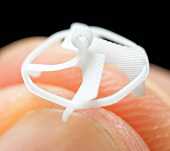| World’s Smallest Wireless Flying Robot Takes Off |
| Friday, 02 May 2025 | |||
|
A new insect-inspired flying robot has been created by engineers at the University of California, Berkeley. The robot can hover, change trajectory and even hit small targets. It is less than 1 centimeter in diameter, weighs only 21 milligrams, and the Berkeley team say it is the world’s smallest wireless robot capable of controlled flight.
The robot was described in a paper published in the Journal Science Advances. Liwei Lin, Distinguished Professor of Mechanical Engineering at UC Berkeley is the senior author of the paper. Lin said: “Bees exhibit remarkable aeronautical abilities, such as navigation, hovering and pollination, that artificial flying robots of similar scale fail to do. This flying robot can be wirelessly controlled to approach and hit a designated target, mimicking the mechanism of pollination as a bee collects nectar and flies away.” The problem with such small devices is the power source enabling it to fly, and electronics for flight control. Other small robots have used options such as a tether. As an alternative, Lin and the UC Berkeley team used an external magnetic field to power the device and control the flight path. The robot is shaped like a small propeller and includes two small magnets. Under the influence of an external magnetic field, these magnets are attracted and repelled, causing the propeller to spin and generating enough lift to raise the robot off the ground. The flight path of the robot can be precisely controlled by modulating the strength of the magnetic field. The next largest robot with similar flight capabilities is 2.8 cm in diameter, nearly three times as large as the new flying robot. Fanping Sui, the study co-first author who recently completed a Ph.D. in engineering at UC Berkeley, said: "Tiny flying robots are useful for exploring small cavities and other complicated environments. This could be used for artificial pollination or inspecting small spaces, like the inside of a pipe." The robot is currently only capable of passive flight, and has no on-board sensors to detect its current position or trajectory. It also cannot adjust its movements in real time. This means that while the robot is capable of precise flight paths, a sudden change in the environment such as a strong wind could knock it off course. The team plans to add active control, which would them to change the robot's attitude and position in real time. The other main limitation is the requirement for a strong magnetic field provided by an electromagnetic field coil. The team hopes to make the robot even smaller, down to less than 1 mm in diameter, which could make it light enough to be controlled by much weaker magnetic fields, such as those provided by radio waves. The same team has also created a cockroach-inspired robot that can scurry across the floor and survive being stepped on by a human, and are working on new "swarming" robots that can work together like ants to achieve tasks that would be impossible for individual robots to achieve alone. Wei Yue, co-first author of the wireless flying robot study and a graduate student in the Liwei Lin lab, is also working with 5-millimeter-scale robots that can crawl, roll and spin, and can also work together to form chains and arrays, or do even harder tasks. Yue said: "They could potentially be used in minimally invasive surgery because we could inject a number of them into the body and have them cooperate together to form stents, ablate clots or do other tasks." The study is published in Science Advances.
More InformationUntethered Subcentimeter Flying Robots Related ArticlesHarvard RoboBee Gets New Knees Controlling 5,000 Autonomous Drones Improving Stability In Flapping Wing Robots Festo's BionicSwifts Fly Like Real Birds To be informed about new articles on I Programmer, sign up for our weekly newsletter, subscribe to the RSS feed and follow us on Twitter, Facebook or Linkedin.
Comments
or email your comment to: comments@i-programmer.info |
|||
| Last Updated ( Friday, 02 May 2025 ) |


